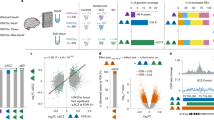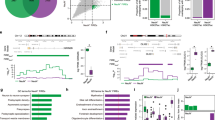Abstract
Although deletions of CHRNA7 have been associated with intellectual disability (ID), seizures and neuropsychiatric phenotypes, the pathogenicity of CHRNA7 duplications has been uncertain. We present the first report of CHRNA7 triplication. Three generations of a family affected with various neuropsychiatric phenotypes, including anxiety, bipolar disorder, developmental delay and ID, were studied with array comparative genomic hybridization (aCGH). High-resolution aCGH revealed a 650-kb triplication at chromosome 15q13.3 encompassing the CHRNA7 gene, which encodes the alpha7 subunit of the neuronal nicotinic acetylcholine receptor. A small duplication precedes the triplication at the proximal breakpoint junction, and analysis of the breakpoint indicates that the triplicated segment is in an inverted orientation with respect to the duplication. CHRNA7 triplication appears to occur by a replication-based mechanism that produces inverted triplications embedded within duplications. Co-segregation of the CHRNA7 triplication with neuropsychiatric and cognitive phenotypes provides further evidence for dosage sensitivity of CHRNA7.
Similar content being viewed by others
Log in or create a free account to read this content
Gain free access to this article, as well as selected content from this journal and more on nature.com
or
References
Ben-Shachar S, Lanpher B, German JR et al: Microdeletion 15q13.3: a locus with incomplete penetrance for autism, mental retardation, and psychiatric disorders. J Med Genet 2009; 46: 382–388.
van Bon BW, Mefford HC, Menten B et al: Further delineation of the 15q13 microdeletion and duplication syndromes: a clinical spectrum varying from non-pathogenic to a severe outcome. J Med Genet 2009; 46: 511–523.
Shinawi M, Schaaf CP, Bhatt SS et al: A small recurrent deletion within 15q13.3 is associated with a range of neurodevelopmental phenotypes. Nat Genet 2009; 41: 1269–1271.
Cooper GM, Coe BP, Girirajan S et al: A copy number variation morbidity map of developmental delay. Nat Genet 2011; 43: 838–846.
Sahoo T, Theisen A, Rosenfeld JA et al: Copy number variants of schizophrenia susceptibility loci are associated with a spectrum of speech and developmental delays and behavior problems. Genet Med 2011; 13: 868–880.
Helbig I, Mefford HC, Sharp AJ et al: 15q13.3 microdeletions increase risk of idiopathic generalized epilepsy. Nat Genet 2009; 41: 160–162.
Szafranski P, Schaaf CP, Person RE et al: Structures and molecular mechanisms for common 15q13.3 microduplications involving CHRNA7: benign or pathological? Hum Mutat 2010; 31: 840–850.
Williams NM, Franke B, Mick E et al: Genome-wide analysis of copy number variants in attention deficit hyperactivity disorder: the role of rare variants and duplications at 15q13.3. Am J Psychiatry 2012; 169: 195–204.
Boone PM, Bacino CA, Shaw CA et al: Detection of clinically relevant exonic copy-number changes by array CGH. Hum Mutat 2010; 31: 1326–1342.
Carvalho CM, Zhang F, Liu P et al: Complex rearrangements in patients with duplications of MECP2 can occur by fork stalling and template switching. Hum Mol Genet 2009; 18: 2188–2203.
Shinawi M, Liu P, Kang SH et al: Recurrent reciprocal 16p11.2 rearrangements associated with global developmental delay, behavioural problems, dysmorphism, epilepsy, and abnormal head size. J Med Genet 2010; 47: 332–341.
Carvalho CM, Ramocki MB, Pehlivan D et al: Inverted genomic segments and complex triplication rearrangements are mediated by inverted repeats in the human genome. Nat Genet 2011; 43: 1074–1081.
Sebat J, Levy DL, McCarthy SE : Rare structural variants in schizophrenia: one disorder, multiple mutations; one mutation, multiple disorders. Trends Genet 2009; 25: 528–535.
Liu P, Erez A, Nagamani SC et al: Copy number gain at Xp22.31 includes complex duplication rearrangements and recurrent triplications. Hum Mol Genet 2011; 20: 1975–1988.
Reddy KS, Logan JJ : Intrachromosomal triplications: molecular cytogenetic and clinical studies. Clin Genet 2000; 58: 134–141.
Bi W, Sapir T, Shchelochkov OA et al: Increased LIS1 expression affects human and mouse brain development. Nat Genet 2009; 41: 168–177.
Beunders G, van de Kamp JM, Veenhoven RH, van Hagen JM, Nieuwint AW, Sistermans EA : A triplication of the Williams-Beuren syndrome region in a patient with mental retardation, a severe expressive language delay, behavioural problems and dysmorphisms. J Med Genet 2010; 47: 271–275.
Yobb TM, Somerville MJ, Willatt L et al: Microduplication and triplication of 22q11.2: a highly variable syndrome. Am J Hum Genet 2005; 76: 865–876.
Girirajan S, Williams SR, Garbern JY, Nowak N, Hatchwell E, Elsea SH : 17p11.2p12 triplication and del(17)q11.2q12 in a severely affected child with dup(17)p11.2p12 syndrome. Clin Genet 2007; 72: 47–58.
del Gaudio D, Fang P, Scaglia F et al: Increased MECP2 gene copy number as the result of genomic duplication in neurodevelopmentally delayed males. Genet Med 2006; 8: 784–792.
Liu P, Carvalho CM, Hastings PJ, Lupski JR : Mechanisms for recurrent and complex human genomic rearrangements. Curr Opin Genet Dev 2012; 22: 211–220.
Shimojima K, Mano T, Kashiwagi M et al: Pelizaeus-Merzbacher disease caused by a duplication-inverted triplication-duplication in chromosomal segments including the PLP1 region. Eur J Med Genet 2012; 55: 400–403.
Dittwald P, Gambin T, Gonzaga-Jauregui C et al: Inverted low-copy repeats and genome instability—a genome-wide analysis. Hum Mutat 2013; 34: 210–220.
Sharp AJ, Mefford HC, Li K et al: A recurrent 15q13.3 microdeletion syndrome associated with mental retardation and seizures. Nat Genet 2008; 40: 322–328.
Hastings PJ, Lupski JR, Rosenberg SM, Ira G : Mechanisms of change in gene copy number. Nat Rev Genet 2009; 10: 551–564.
Schaaf CP, Wiszniewska J, Beaudet AL : Copy number and SNP arrays in clinical diagnostics. Annu Rev Genomics Hum Genet 2011; 12: 25–51.
Zoghbi HY, Warren ST : Neurogenetics: advancing the "next-generation" of brain research. Neuron 2010; 68: 165–173.
Lupski JR : Brain copy number variants and neuropsychiatric traits. Biol Psychiatry 2012; 72: 617–619.
Crespi BJ : Revisiting Bleuler: relationship between autism and schizophrenia. Br J Psychiatry 2010; 196: 495; author reply 495–496.
Lin H, Vicini S, Hsu FC et al: Axonal alpha7 nicotinic ACh receptors modulate presynaptic NMDA receptor expression and structural plasticity of glutamatergic presynaptic boutons. Proc Natl Acad Sci USA 2010; 107: 16661–16666.
Vinals X, Molas S, Gallego X et al: Overexpression of alpha3/alpha5/beta4 nicotinic receptor subunits modifies impulsive-like behavior. Drug Alcohol Depend 2012; 122: 247–252.
Kem WR : The brain alpha7 nicotinic receptor may be an important therapeutic target for the treatment of Alzheimer's disease: studies with DMXBA (GTS-21). Behav Brain Res 2000; 113: 169–181.
Acknowledgements
We are indebted to the family who participated in this study. Dr Schaaf’s work is generously supported by the Joan and Stanford Alexander Family. Dr Schaaf is also a recipient of a Doris Duke Clinical Scientist Development Award. NIH grant HD037283 supported Dr Ge’s work in the laboratory of Dr Arthur Beaudet. In addition, this work was supported in part by US National Institute of Neurological Disorders and Stroke grant NS058529 to JRL.
Author information
Authors and Affiliations
Corresponding author
Ethics declarations
Competing interests
Drs Carvalho, Lupski, Stankiewicz, Cheung, Bi and Schaaf are faculty members of the Department of Molecular and Human Genetics at Baylor College of Medicine, which derives revenue from the chromosomal microarray analysis offered in the Medical Genetics Laboratory.
Rights and permissions
About this article
Cite this article
Soler-Alfonso, C., Carvalho, C., Ge, J. et al. CHRNA7 triplication associated with cognitive impairment and neuropsychiatric phenotypes in a three-generation pedigree. Eur J Hum Genet 22, 1071–1076 (2014). https://doi.org/10.1038/ejhg.2013.302
Received:
Revised:
Accepted:
Published:
Issue date:
DOI: https://doi.org/10.1038/ejhg.2013.302
Keywords
This article is cited by
-
Translational implications of CHRFAM7A, an elusive human-restricted fusion gene
Molecular Psychiatry (2024)
-
Chromosome 15q13 microduplication in a fetus with cardiac rhabdomyoma: a case report
Molecular Cytogenetics (2019)
-
Inhibition of breast cancer cell proliferation and tumorigenesis by long non-coding RNA RPPH1 down-regulation of miR-122 expression
Cancer Cell International (2017)
-
Chrna7 deficient mice manifest no consistent neuropsychiatric and behavioral phenotypes
Scientific Reports (2017)
-
Copy Number Variants in Patients with Autism and Additional Clinical Features: Report of VIPR2 Duplication and a Novel Microduplication Syndrome
Molecular Neurobiology (2017)



